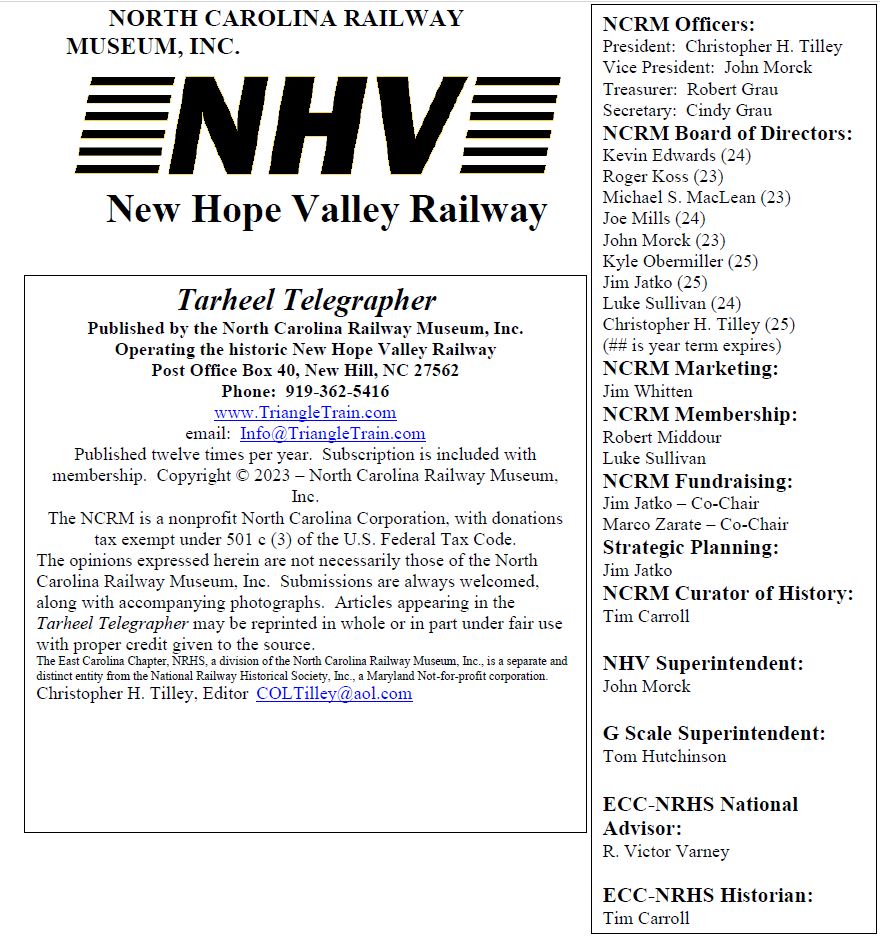Volume 63 – Issue 11 1 November 2023
From the Brass Hat
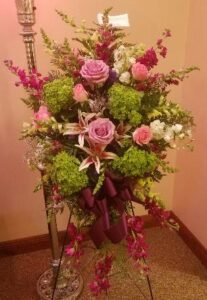 Gina and I gratefully thank everyone for their sincere expressions of sympathy and condolences upon the passing of my mother. The beautiful flowers from the NCRM were a pleasant surprise. All the kind words, thoughts and prayers buoyed us up through the hard days. My mom was a fan of the NHV and had many enjoyable rides on our rails. She was impressed with the professionalism of the volunteers. This was borne out by the seamless execution of the final two Halloween rides, despite the absence of Gina and myself. Kudos to Karen Profitt and Dave Brook who picked up our slack at the Witches’ Path and put on a really good show. We actually got to ride the train for the first time in TEN years and it was quite entertaining and sufficiently spooky to boot! The yard looked amazing, since we had only seen it when the character train gets back. It was nice to sit for a few minutes to take in the Singing Pumpkins and other excellent décor everyone worked so hard to set up.
Gina and I gratefully thank everyone for their sincere expressions of sympathy and condolences upon the passing of my mother. The beautiful flowers from the NCRM were a pleasant surprise. All the kind words, thoughts and prayers buoyed us up through the hard days. My mom was a fan of the NHV and had many enjoyable rides on our rails. She was impressed with the professionalism of the volunteers. This was borne out by the seamless execution of the final two Halloween rides, despite the absence of Gina and myself. Kudos to Karen Profitt and Dave Brook who picked up our slack at the Witches’ Path and put on a really good show. We actually got to ride the train for the first time in TEN years and it was quite entertaining and sufficiently spooky to boot! The yard looked amazing, since we had only seen it when the character train gets back. It was nice to sit for a few minutes to take in the Singing Pumpkins and other excellent décor everyone worked so hard to set up.
On a much happier note, our Halloween trains were a great success! My unofficial count was 4479 riders over the four days. I have received many positive comments on the entire operation, so many thanks to all who were involved in the prep and execution of our second-highest attendance event for the year. Christmas trains are lurking just around the corner. In other areas of the life of the Museum, the Board of Directors election went flawlessly. John Morck was reelected and we welcomed Art Kotz and Tim Carroll to the Board. Our sincere thanks to Roger Koss and Mike MacLean who served on the board for decades, bringing us from a small-time operation to a much larger presence in the Rail Preservation community. Of course, we value their continued participation and irreplaceable expertise in the workings of our Museum and Railroad.
Thanks for all you do for our Museum.
Respectfully submitted,
Chris Tilley
President, NCRM
Get to Know a Member: Dave Dick
Name: Dave Dick
How long have you been a member? Since 1992
Where are you originally from? San Gabriel, California
What were your job(s) in real life? Design Engineer/Mechanical Engineer, retired
Where do you live now? Mars Hill, NC
Any family…spouse, kids, grandchildren? My wife Nancy and I have 2 daughters Emily and Rebecca. We have two grandchildren Amelia and Michael Thomas. All are up here near Asheville.
How did you become interested in trains? I’ve always been interested in trains from the time I was about 5 years old. I grew up in San Gabriel, California. Ward Kimball of Disney fame and owner of the Grizzly Flats Railroad was also a neighbor in San Gabriel. On the weekends, Mr. Kimball would run his trains up and down his driveway and when we would hear the steam whistle, Dad and I would go over and spend the day riding behind Chloe.
I went to work for the Virginia and Truckee Railroad in the early 1970’s as a carpenter and mechanic. I was 17 years old at that time. By 19, I became a fully licensed steam locomotive engineer.
What is your favorite activity at the New Hope Valley Railway? My favorite activity is research and restoration. I’ve done a lot of work on the Goldston Depot, as well on both our steam locomotives. Currently I’m advocating for the restoration of 110, our 2-6-2 Prairie-type. It might not look like it now, but we have already got a lot of up-front work done on the engine. I’m going to explain more about some of that work in a future article for the Tarheel Telegrapher.
If you do not receive the operating crew calls, please contact the crew caller if you are interested in participating in train operations!
It’s 2024 Membership Renewal Time
by Tom Hutchinson
The Board voted in October to maintain 2023 member dues levels for 2024: $20 for adult (18+), $5 for each additional family member and $15 for youth (14-18). The membership of everyone not a lifetime member expires on December 31, so annual members should renew their membership by then. There is a 60-day grace period after December 31 to maintain your membership in good standing.
In November, Tom Hutchinson will send an email to all annual members through the membership software program, Springly, inviting them to renew their membership. Membership may be renewed by credit card this year as well as by check. If you want to renew by cash, you will need to get your payment to Robert Middour or to Tom before year-end.
As we are all getting up-to-speed on how the new membership software system works, Tom will place a link in the next Tarheel Telegrapher that you can use if you did NOT receive an email in November (or lost it). Tom will also be following up with individual members in December who have not renewed.
Acquiring Two of Our Larger Assets – The Goldston Depot Part 1
by Dave Dick
I’ve always had this optimistic vision of what we could be as a museum, and never focused on why we couldn’t get there. So, when the opportunity to acquire a historic depot came along, I knew it would become one more piece in a collection that I believe will eventually set us apart from other museums. But first, the story about how the deal came about is a perfect example of why you shouldn’t be afraid to step out of you comfort zone to ask a simple question, “Would you be willing to make it a donation?”
Actually, we had a great team of folks who worked very hard to make the donation a reality, but the conversation had to start somewhere. So, in steps Jack Johnson. Jack and I have been very good friends and partners for about fifteen years now. He’s an expert at all things steam, especially stationary steam. He has been a driving force behind the steam equipment out at Silk Hope and at the Ederville Train and Tractor show in Carthage. He also knows a lot about antique saw mills. If you saw mill guys aren’t talking to Jack, then you’re missing out on a valuable resource. Most of all Jack enjoys talking to people.
In mid to late 2014, he was driving through Goldston, NC, and noticed the depot sitting on a lot just off main street. He then contacted me after that to discuss what he had found. We agreed that it wouldn’t hurt to find out a little more information on the building and who owned it. Here’s some of what we found. The Goldston Depot was originally built for the Cape Fear and Yadkin Valley Railway in 1884. The Southern Railway took over ownership in 1899 after the CF&YVRY went bankrupt. The colors on the depot today reflect the Southern Railway colors as it might have been painted in the early 1900’s. Because of increased freight traffic, two more freight doors were added in 1908, pushing the office area out to where it is today.
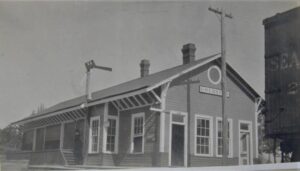 In the 1920’s a passenger ticket area was added extending the building out approximately another fifteen feet. The picture below shows the building after all construction was completed. The depot station number CF117 (listed in a description of all railway structures along that part of the railway) includes several important pieces of information as to its function. The depot acted as a freight and local passenger ticket agency. The depot served as a spot at which local passenger trains stopped to take on or let off passengers. Both carload and less than carload freight could be handled inbound as well as outbound. It was also a Post Office where money orders were also sold. The station agent also acted as the Agent for the Express Company delivering packages locally. A placard above one of the freight doors still has the depot number CF117. An ICC report done for valuation in the 1930’s described the depot this way. “The ICC engineer described the Goldston station as 23 feet x 72 feet 6 inches with a high wood platform 4 foot, six inches wide on each side and end of the freight room. The platform was boarded up to 4 foot high with 2-inch boards. 35 12-inch x 12-inch wood posts supported the freight end. The freight room floor was 36 inches above the passenger room floor.
In the 1920’s a passenger ticket area was added extending the building out approximately another fifteen feet. The picture below shows the building after all construction was completed. The depot station number CF117 (listed in a description of all railway structures along that part of the railway) includes several important pieces of information as to its function. The depot acted as a freight and local passenger ticket agency. The depot served as a spot at which local passenger trains stopped to take on or let off passengers. Both carload and less than carload freight could be handled inbound as well as outbound. It was also a Post Office where money orders were also sold. The station agent also acted as the Agent for the Express Company delivering packages locally. A placard above one of the freight doors still has the depot number CF117. An ICC report done for valuation in the 1930’s described the depot this way. “The ICC engineer described the Goldston station as 23 feet x 72 feet 6 inches with a high wood platform 4 foot, six inches wide on each side and end of the freight room. The platform was boarded up to 4 foot high with 2-inch boards. 35 12-inch x 12-inch wood posts supported the freight end. The freight room floor was 36 inches above the passenger room floor.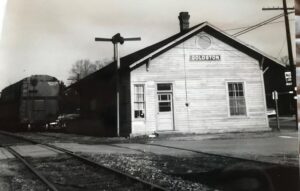
Freight room walls were lined to 6-feet high with 1-inch boards and the floor was wood planks. Brick piers 24 inches square supported the passenger end. The passenger platform had 275 yards of chert (a flint like gravel) laid 9 inches thick. There was 105 feet of 7-inch x 16 inch and 60 feet of 3-inch x 12-inch wood curb containing the platform chert.
A stock chute, painted two coats, was also in place at the valuation. A 10-foot x 12-foot x 8-foot section tool house was also on the property. The ‘Type 13’ tool house had a 11-foot 6-inch gable roof described as identical with the tool house at Dalton. By the 1940’s and 50’s passenger service had dropped off to a point where the passenger end of the depot was no longer needed and was removed. This is when Goldston Depot approximately 1950’s the depot took on its present-day look. By the end of the 1960’s the depot, no longer used, was slated to be torn down or burned to clear the right-of-way. Arthur Gaines, a local business man, stepped in and acquired the building to use as storage and moved it to his property on Hillcrest Avenue, about three blocks from its original position on the railroad. He also moved the section tool house which 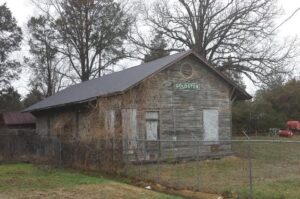 at the time was placed behind the depot. The tool shed roof can be seen here on the picture below, just beyond the depot. Here the depot would sit for another forty years.
at the time was placed behind the depot. The tool shed roof can be seen here on the picture below, just beyond the depot. Here the depot would sit for another forty years.
After a little digging, Jack found out that it was still the Gaines family who owned the depot. Todd, who was the son of Authur Gaines, who originally moved the depot off railroad property, was the owner and CEO of Gaines Oil Company there in Goldston. He agreed to meet with Jack to talk about the depot, where they discussed a possible donation to the North Carolina Railway Museum. Todd was receptive to the idea because of other ideas he had for the property. He also mentioned that saving the depot was very important to his dad, so he had to consult with the rest of the family for direction. For the next few months Jack and I pretty much kept this information to ourselves. Although he and I were pretty excited about the possibility, it was also possible that another organization or museum might get wind of the donation and go after it themselves. I met with Todd a couple of times during that period to discuss any questions he might have about the donation or the museum itself. It was still too early in the negotiations to report back to the Board of Directors about what we were hoping to do, and we made it clear that any donation would be contingent upon the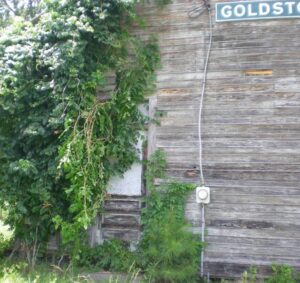 approval of the Museum Board of Directors. We were getting closer but it still wasn’t clear that the family wanted to donate the depot.
approval of the Museum Board of Directors. We were getting closer but it still wasn’t clear that the family wanted to donate the depot.
There were a couple of other things I felt needed to be done before doing any presentation to the Board. In 1987, downtown Goldston was placed on the National Register of Historic Places and became the Goldston Commercial Historic District. I needed to find out if the depot would be affected by that declaration in some way. After some research, I discovered that the depot, because it had been moved from its original location, didn’t qualify as being part of the historic district. It was also outside the boundary which meant moving the depot wouldn’t be a problem. I also wanted to get a good idea about what the move was going to cost us. Jack took it upon himself to find a company that would come out and take a look at the building and give us a quote.
At the same time, we were able to get inside the gate to inspect the depot both on the inside and out. Structurally the building was sound. Heavy beams supported the freight end of the building, even though the concrete blocks under those beams were falling apart or sinking into the ground. It seemed to be holding up. Nature was starting to take a toll on the outside as well. Vines were growing up and underneath the original German siding. Small animals had taken up residence within the walls. Squirrels and mice build nests, and if not controlled, will retain enough moisture to rot the interior structure, not to mention attracting other unwanted pests like termites or other wood-loving insects.

 The platform was deteriorated to the point that it was dangerous to walk on. Somebody had tried to patch over the holes with sheet Vines growing on outside of depot metal which made walking on the platform that much more perilous. One shining note is that the depot did have a new metal roof that had been put on recently. On the interior, the first thing that was noticeable was that the back wall of the office was starting to sag because of a lack of support under the building. Much of the trim was displaced, and cracking was starting to appear where the chimney is now. The weight of the building itself was pushing the support blocks underneath the building into the ground due to standing water. Although the depot had been there for quite some time, it was obvious there was no longer enough concrete block underneath to support its weight. The depot would need a new foundation very soon.
The platform was deteriorated to the point that it was dangerous to walk on. Somebody had tried to patch over the holes with sheet Vines growing on outside of depot metal which made walking on the platform that much more perilous. One shining note is that the depot did have a new metal roof that had been put on recently. On the interior, the first thing that was noticeable was that the back wall of the office was starting to sag because of a lack of support under the building. Much of the trim was displaced, and cracking was starting to appear where the chimney is now. The weight of the building itself was pushing the support blocks underneath the building into the ground due to standing water. Although the depot had been there for quite some time, it was obvious there was no longer enough concrete block underneath to support its weight. The depot would need a new foundation very soon.
The interior of the freight section was full of items that belonged to the Gaines family. Until that was cleaned up, we couldn’t really assess the condition of the floor. The walls though were the surprising factor. They were covered in graffiti put there by multiple train crews and station personnel for many years. The earliest date found was from the mid 1880’s. The older set of freight doors looked to have their original hardware. The 1908 set of freight doors had completely different hardware. Looking at the roofline inside, you could see a clear delineation between the older construction and the newer construction. There may have been many changes made to the depot over the years, but all of that history survived on the inside of the freight area. That’s when we knew we were onto something.
I believe it was mid-to-late 2016 before we heard back from Todd Gaines. The family gave its consent to donate the building. Todd was going to have the building appraised so that he could write it off. We also at some future date needed to honor his dad Authur as the one who saved the depot. We got a quote back from a moving company who were very excited about moving this particular historic building. Oldham House Moving was the company that moved the depot the first time off the railroad property. Things were now falling into place, and I had enough information to present it to the Board of Directors. This type of donation doesn’t happen every day, and there were questions that only the Board could answer. The Board was supportive and approved the project, including full funding of the moving costs. Folks were put to work to answer questions like, “Where are we going to put it?”. Mark Duerst was appointed project manager, and I got started on designing a new foundation.
It would be another nine months before the building was actually moved. The moving company needed to figure how to move it as well as acquire the necessary permits. That gave the museum enough time to prepare for its arrival. Again, we put together a great team who met the challenge.
enough time to prepare for its arrival. Again, we put together a great team who met the challenge.
I’ve put together a lot of information on this project. I took a lot of notes and photos so that one day I could record the historical narrative as accurately as possible. That’s why I have chosen to make this article in two parts, plus I didn’t want to take up the entire Telegrapher issue! Stay tuned for information on the move and restoration of the depot.
[Editor’s note: If you have photos or other info about long-ago (or recent) events at the NCRM, please contact your editor. You can submit your own “Back in the Old Days…” or other article with pictures about anything (within reason) from our past for the Telegrapher. If you can rough out the ideas, we can work with you to craft an article to benefit the entire membership. – CT]
Back in the Old Days Video
by Victor Varney
For those of you that have been around the NHVR for 20 years or more, you may remember a gentleman that took lots of pictures of the NHVR during those days. His name is Tim Telkamp. He published a short paperback book with black and white photos of the NHVR back then. He also created a really nice video of a slide show of color photos with music. We found a copy of the old Video CD (pre DVD) which was a bear to get converted to MP4 format. Click here to be taken to the DropBox link. A real step back in history! Note the copyright messages at the end says this is OK for viewing by NCRM members.
A Large Layout for a Small Space
by Dave Chasco
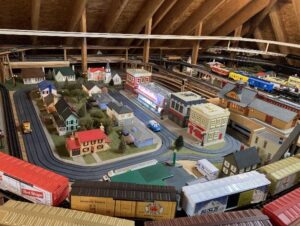 [Ed note: the following is a synopsis of a larger article by Dave Chasco published in the TCA electronic magazine (link below). We wanted to share this success with the membership – trains of ALL sizes are lots of fun!]
[Ed note: the following is a synopsis of a larger article by Dave Chasco published in the TCA electronic magazine (link below). We wanted to share this success with the membership – trains of ALL sizes are lots of fun!]
With a grandfather, father and 3 uncles working for “the railroad”, and being the first grandchild, I grew up in the yards and buildings of the CNW (Chicago & North Western Railroad). So, when I got my first model train, I had visions of building a railroad empire though it wasn’t until my wife, Carmen and I moved into our first home in 1971 that I got started on it.
So, just what does a (model) railroad empire look like? A lot of operating trains, long mainlines and yards, lots of bridges, scenery, homes and businesses, running roadways, lighting and signage, and more! We’ve all seen large layouts like this in train depots, museums, clubs, train shows and even private tours. What I had at the time was a transformer, a Lionel steam engine, tender and 4 cars and an 8-foot loop of track and not a lot of space.
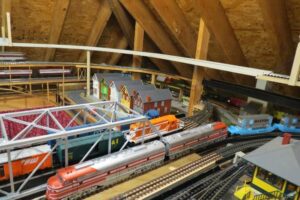 It sounds like that would have taken decades and a lot of space, but it didn’t. And yes, organizations have way more space, finances and manpower, but it took me only 3 years – the time it took to acquire enough track and trains! My first layout was a 275 square foot table top in the basement, with a 438 foot mainline plus 5 other operating loops and a classification yard, using 708 total feet of track. My second was 425 square foot layout, also in the basement, that had a 589 foot long mainline and 4 additional multi-train routes. I ran typically 7 trains but alternated 17 over a total of 1133 feet of track. These were far smaller in size than you’d see in club or organizational layout, but packed in a lot of operation and fun.
It sounds like that would have taken decades and a lot of space, but it didn’t. And yes, organizations have way more space, finances and manpower, but it took me only 3 years – the time it took to acquire enough track and trains! My first layout was a 275 square foot table top in the basement, with a 438 foot mainline plus 5 other operating loops and a classification yard, using 708 total feet of track. My second was 425 square foot layout, also in the basement, that had a 589 foot long mainline and 4 additional multi-train routes. I ran typically 7 trains but alternated 17 over a total of 1133 feet of track. These were far smaller in size than you’d see in club or organizational layout, but packed in a lot of operation and fun.
 What exists today, my third layout, is 5-levels, with over 1225 feet of track, and a mainline that is 379 feet long. There are 23 trains on the layout with usually 10 running at any time. There are 12 Superstreet™ (now Easystreets™) roadways, over 115 lighted buildings, and 20+ lighted or animated signs. You’ll also see numerous (homebuilt) bridges, some as long as 10 feet and one with over 3000 pieces. It also has 20 transformers for train and Superstreet™ operation and 4-9 VDC adapters for lighting and signage. And just enough equipment to run. All of this in 406 Square feet of table top (Approx. 20×20 for reference.)
What exists today, my third layout, is 5-levels, with over 1225 feet of track, and a mainline that is 379 feet long. There are 23 trains on the layout with usually 10 running at any time. There are 12 Superstreet™ (now Easystreets™) roadways, over 115 lighted buildings, and 20+ lighted or animated signs. You’ll also see numerous (homebuilt) bridges, some as long as 10 feet and one with over 3000 pieces. It also has 20 transformers for train and Superstreet™ operation and 4-9 VDC adapters for lighting and signage. And just enough equipment to run. All of this in 406 Square feet of table top (Approx. 20×20 for reference.)
The common feature of all three of my layouts is the length of the mainline: my Mobius strip concept. To make this, take two levels of a double track mainline and make the 4 loops into one long run. It’s not complicated as there are 3 graphical solutions that require no switches or crossovers, out of 24 possible solutions. Why is this important? Because instead of 4 trains making endless loop-de-loops every 30-40 seconds or so, it now takes closer to 3-1/2 minutes. Not only that, but they pass the observer twice, once clockwise and once counterclockwise. And to make it even more interesting, this design iteration has a hidden siding that allows the operator to add or subtract a train, juggle their order or swap another in and out!
mainline and make the 4 loops into one long run. It’s not complicated as there are 3 graphical solutions that require no switches or crossovers, out of 24 possible solutions. Why is this important? Because instead of 4 trains making endless loop-de-loops every 30-40 seconds or so, it now takes closer to 3-1/2 minutes. Not only that, but they pass the observer twice, once clockwise and once counterclockwise. And to make it even more interesting, this design iteration has a hidden siding that allows the operator to add or subtract a train, juggle their order or swap another in and out!
 It also doesn’t take a lot of space to do, just a little imagination.
It also doesn’t take a lot of space to do, just a little imagination.
For me, the fun doesn’t stop there. In fact, if anyone asks, I call my hobby a kinematics, electronic, mechanical, and physics lab. Like any empire, it takes maintenance and upgrading. For example:
A) Trucks wore out after about 130 hours of operation
– I studied lubricants and use a grease today
– All the plastic trucks were changed to ones that had metal side frames
B) To pull long trains, motors were added to engines – powered and originally non-powered – and control cards upgraded
C) All bulbs have been replaced with constant voltage LEDs (To prevent heat damage)
D) Original track was upgraded to Gargraves which has a wide variety of curves
E) Switches, wyes, slips and crossovers were extremely hard to get to fit, so I scratch-built mine. (The last one was retired just recently after 28 years of use!)
F) Handling and storage of equipment often damages their appearance. Mine are all stored in plastic bags (bought at a local grocery store) and in their boxes.
G) Adapting Slot cars to trains was a project I worked on while at K-Line called SuperStreets™ (now EastStreets™)
H) All the bridges are custom. The lenticular (trolley) bridge is scaled from a picture. It has over 3000 pieces. There are several others of different types over 100” long.
I) I started with Plasticville™ buildings but today there are many sources and a wide variety to choose from, so only a few ‘historic’ buildings still remain from the original purchases of 50 years ago.
J) I am NOT artist in any way and also because what is available today that wasn’t 50 years ago, upgrading and adding does require demolition and removal. In fact, I have added two additional levels to my layout in recent years. So, I did not ballast or use hard scenery on this layout. I have some Woodland Scenic™ trees, though.
The images are a walk around my attic; see if you can find all 23 trains out there! Click here to visit the Train Collectors Association website.




